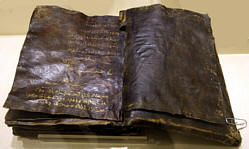 |
The Kolbrin, or The Kolbrin Bible, is a collection of texts alleged to be the translation of an ancient manuscript originally housed in the Library of Alexandria.
During the 1920s and 30s these books were said to be in the possession of a religious group in England . During World War II the old books were thrown out as “worthless junk”, but were saved, later discarded as “heathen works of the Devil”, and again salvaged before irreparable damage was done. Finally it is claimed, the texts ended up in the hands of the Culdian Trust, formed in 1980. The current version of the text was produced by "an elderly man from the Hope Trust" around 1992, working from whateer texts were available.
No old manuscript or evidence of literary or scholarly references to it are available. In particular, the publishers not only have no manuscript to exhibit, but there are noclaims of ownership other than vague allusions to an unnamed religious group and a unknown medieval cult called the Culdians. The foreword states that the text "has been adequately validated and endorsed by Higher Authorities" without naming them. The introduction then adds, "Undoubtedly, additional material has been incorporated with good intent, to fill gaps and elaborate on the original", and further that "No claim is made regarding historical accuracy", but that its origin is unimportant.
The Kolbrin was originally just called The Kolbrin until American publishers decided to add the word Bible
The Kolbrin Bible comprises eleven books. The first six books are said to be scribed by Egyptian writers shortly after the exodus, and they are treated as a single volume is called Bronzebook. Incorporated in the modem Kolbrin are manuscripts which are claimed to have been copied from salvaged manuscripts which were transcribed on to metal plates and formed a work known as “The Coelbook”. There is a second volume to it - the Gospel of the Kailedy and deals specifically with the life and times of Jesus Christ.
Currently there are three editions of the material:.
1) A hardbound edition, published in association with the Culdian Trust. It is divided between two volumes - The Kolbrin and The Gospel of the Kailedy;
2) the same group has also produced an online edition.
3)A softcover edition is published by Your Own World Books, edited by
Janice Manning and compiled by Marshall Masters
A voice text of the Book is available on YouTube.com ,
the first video can be found at:
https://www.youtube.com/watch?v=Lx5g7oc2zgc
Myths
about the Book
The Kolbrin is purported to be a 3600 year old book in the form of a
scroll
penned by Egyptian scribes after the Hebrew Exodus.
It
was housed in the Library of Alexandria,
Egypt, along with about 700,000 other scrolls which contained the history
and knowledge of the ancient world. When Julius Caesar invaded Egypt in
48 B.C at
the time of Cleopatra, the library was burned . However, some
few scrolls were saved by people who removed them from the library
before it was totally consumed in theconflagrations of the first
centuries of the Christian era..
Less
than a thousand years BC,
Phoenician papyrus traders translated The Great Book from Egyptian
Hieratic into their 22-letter alphabet and entrusted a copy to the
Celtic priests in Britain around the time that the
New Testament was being created.
There they were
stored in the Glastonbury Abby in Summerset County, for hundreds of
years. The first section transcribed to bronze sheets and placed in clay
containers, then stored in a safe place in the Abby’s Library allowing
them to survive the fire of 1184, though damaged. The text's
publishers allege the fire was set to destroy these and other
heretical texts.
These
plates were known as The Bronzebook of Britain. The texts are then
alleged to have been transmitted through a series of owners, including
one John Culdy in the early 1300s. Eventually being entrusted to "a
small religious group in England" and thence to the Hope Trust, "of
which little is known." They were written out in book form in the
seventeenth century.
Finally the texts are claimed to have ended up in the hands of the Culdian Trust, formed in 1980; they claim that the current version of the text was produced by "an elderly man from the Hope Trust" around 1992, working from the original texts.